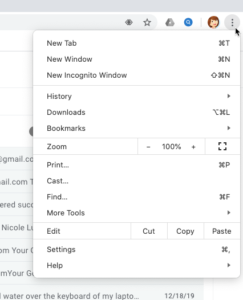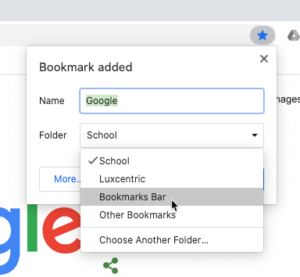Organize Your Child’s Computer for Online School
As a parent, you already have a system for how to help your child succeed in school. I always boiled my list down to these basics.
- Set a reasonable bedtime
- Offer good and healthy food
- Communicate with their educators
- Provide a place for them to do homework and study
This last item is where this post about online school will focus.
The Specifics for Online School
With online school, you will need more than just a table and chair. You will need a digital device connected to the internet. Ideally, this device will be either a laptop or desktop computer. Tablets and smartphones are less ideal. Your first step in preparing your child for online school is to determine what their computer situation will be.
- Will they be sharing your computer with you?
- Will they share a computer with a sibling?
- Will your children each have their own computer?
Your goal is to establish a set up that makes it easy for your child to access the stuff they need for school without getting it muddled with everything else. You also need a reasonable way to monitor them and help them as they do their work.
The Basic Elements of Online School
- Online school will start with your child’s computer screen (desktop) and its controls.
When your child turns on the computer, they should be able to open what they need quickly. Having everything in an easy to find and consistent location on the computer screen will enable you to actually say “do your schoolwork” and have them be able to get started on their own.
- The primary tool they will use within the computer will be a browser
(The program that navigates the internet). The most common browsers I work with are Chrome, Edge, Safari, and Firefox. We will need to determine which browser you want them to use and how to set it up.
Let’s Choose a Browser
Chrome, Edge, Safari, or Firefox? You are busy, you have better things to do than figure out which browser to use.
For this adventure I recommend Chrome. It is the only one that is able to reliably do all the things I will recommend. We can compare browsers later, for now let’s just use Chrome and get this done.
By its very nature, online school will use several websites and other online tools that can be organized within the features of Chrome. There are a few settings you may need to adjust to take full advantage of what Chrome can do for you.
You will gain the most benefit by associating your browser with a browser profile account. For Chrome, this means a Gmail account. Every Gmail account has a Chrome browser profile attached to it whether you use it or not.
This means that your first order of business for your child is to set up individual Gmail accounts for each of them. Yes, each child needs their own Gmail account, an account you will be able to monitor.
Establish Your Child’s Chrome Account
One of the marvelous things about the Chrome Browser is that it allows you to have multiple browser profiles open at the same time. This means that while you are at your own computer you will be able to log into your child’s browser account and organize their favorites, passwords, and review their history even if they are using a different computer. If you share a computer, this will allow them to open their own browser profile and not mess up your stuff. Kids?! Right!

Take a look at the Chrome dashboard.
In the upper right corner of the dashboard is the mini profile icon of your browser account. It is often the same profile icon as your Gmail account, but smaller. Click on that mini profile icon.
This will open the option to add or create an account. Go through the steps of entering your information and be sure to allow the data to sync at the end. You may need to reconnect the sync from time to time. When your mini profile icon says “paused” it is time to re-sync. Click on the icon to login again to reconnect it.
If you are all on the same computer you will notice that when you click on your mini profile icon you will see a list of the other Chrome accounts you have access to. When you choose another Chrome account it will open in a separate browser window that will contain the favorites and settings associated with that account.
Your Task
- Identify or create Gmail accounts for your children and log in
Take a tour of the settings in Chrome
Sometimes Chrome defaults to the settings you need and sometimes you need to turn them on or off. Find the settings for your Chrome.
Currently,* settings are found in the upper right corner of the dashboard next to your mini Chrome profile. When available they will be represented by 3 dots.
If the 3 dots are missing you will need to do some Chrome maintenance. Click on whatever is there and follow the instructions. Enable or disable extensions (orange) or update Chrome (Green).
Eventually, you will see the 3 dots.
- Turn on your Bookmarks bar
This bar will live within the dashboard of your browser and you will be able to organize all the different websites involved in your child’s school where they can be found easily.
- Review the password manager within Chrome.
Chrome has the ability to capture login and password information within its system, making it easy to successfully log in to all the various sites your child may need. You are also able to view these passwords in the Chrome settings.
- Check out the history
Occasionally you will need to clear out the cookies and cache of your child’s browser to keep everything running smoothly. Make this a regular task and include a quick look at your child’s history list to make sure they are on track.

Your Tasks:
- Turn on your bookmarks bar in Chrome. (3 Dots – Bookmarks – Show Bookmarks Bar)
- Visit the password list in Chrome. (3 Dots -Settings – Passwords)
- Check out the browser history and notice how to clear the cookies and cache. (3 Dots – History – History – Clear Browsing Data)
Let’s Optimize the Browser
Now that your browser is identified and your child’s Chrome account is set up we can get to the fun stuff. As a parent/guardian you have most likely been given a ton of resources (links to websites) of all the things that will help you and your child navigate this online school thing. It is time to go find these lists and set them up.
Let’s start with the first resource.
The best resource to start with is the website that your child will use as their primary login. Visit that site and go through the process of logging in. If you already know the login credentials, then let the Chrome browser save the information. If you turned on the save passwords feature in settings it will ask if you want to save this information. You can say ok.
Note: If this is your first time logging in you may need to establish a new password. Do not let your password manager save your password until you are satisfied with what you plan to use. Just tell it “not now” if it tries to save it before you are ready.
Once you are safely logged on you can save this site to the “Bookmark bar”.
Click the star in the Chrome dashboard and it will automatically save it to the last location you used. If this is not your “Bookmark Bar” you will need to set it.
After you have this first site bookmarked, the rest are even easier.
As you work you will notice that the entries will span across the bookmark bar. Eventually, your bookmark bar will fill up and the entries will “fall off the edge”. When this happens you are ready for bookmark bar folders. These folders exponentially expand your bookmark bar way beyond anything your child will ever need.
Your Task:
- Bookmark the sites your child will need to access in their Chrome account.

Now for Some Power Organizing
When you have bookmarked each of the web pages important to your child’s learning you can determine if they are limited enough to span the toolbar and still be easily seen and accessible to your child or if further organization is necessary. If any of the bookmarks “falls off” the bar then we will need to create folders.
Here are a few folder organization ideas. Use the ones that resonate.
Don’t get too complicated, it can be as simple as
- School – classroom portal, assignment lists, school dashboards, homework download pages.
- Fun – for games and personal Interests
Or more complicated like
- Math
- English
- Science
- Research
As your child progresses, categories will become more clear. Add them as you need.
Often you will need a website that is comprised of several links to other pages. It is ok to bookmark just the main page. It is also ok to bookmark a few of the pages your child needs to visit regularly.
Your Tasks
- Organize your Bookmarks
Regularly Monitor Your Child’s Chrome Account
Here are some truths;
You are busy.
It is not reasonable to monitor your child’s internet activity 100 percent of the time.
You are the best authority on how much supervision your child needs.
Here are the things you can evaluate regularly. (You decide what regularly means – I generally consider it a week for this)
Their bookmarks
Whether you teach them or they figure it out on their own your child may create their own bookmarks. You have the opportunity to help them learn sustainable organizational skills.
When bookmarks fall off the bar you can create folders. You can delete duplicate or old bookmarks. You can show them how to maneuver their bookmarks into folders.
The browser history
Your kids will get curious and will search for things, random things, weird things. This is perfectly normal and you can investigate their history to remain aware of the things they are interested in and curious about. They may find some really fun things for you to enjoy together.
Clear cookies and cache
When the cache is full the internet misbehaves. This is one of the most useful troubleshooting techniques out there. Just below turning it off and back on again.
Your Tasks:
- Review bookmark organization
- Evaluate history
- Clear cookies and cache.
Your Child’s/Children’s Computer
Now that you have set up your child’s browser account you can load it onto the computer they will use. This might be your computer, or it might be their computer. This is where the power of Chrome accounts is most useful.
Your last step, if you choose, will be to add these Chrome accounts as icons on your desktop or toolbar/dock.
Your Tasks
- Sign into the Chrome accounts on your computer and your children’s computers.
- Create shortcuts on the desktop.
PC: 3 Dots – Settings – Chrome Name and picture – Look for little switch
MAC: Choose a specific webpage – 3 Dots – more tools – Save page as…
*Note: The “how-to” of anything in technology is subject to change and would likely be out of date almost as soon as I hit “publish” on this blog.
See you around the internet,
Nicole


